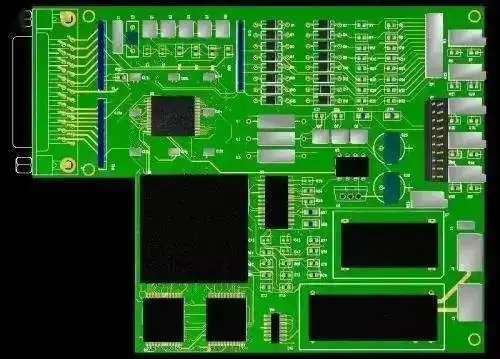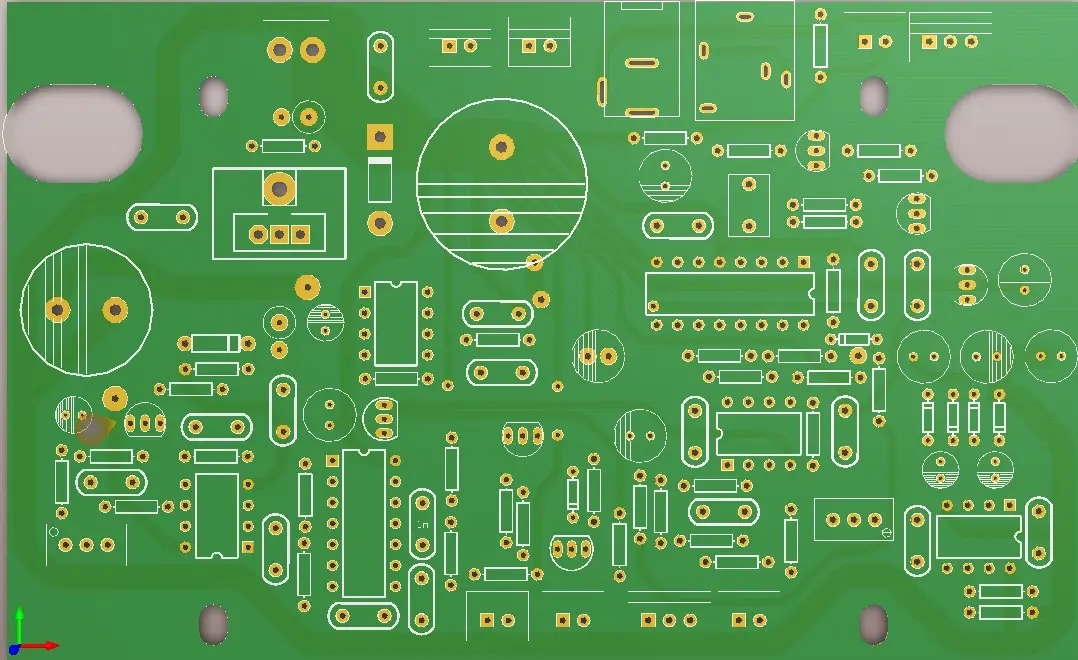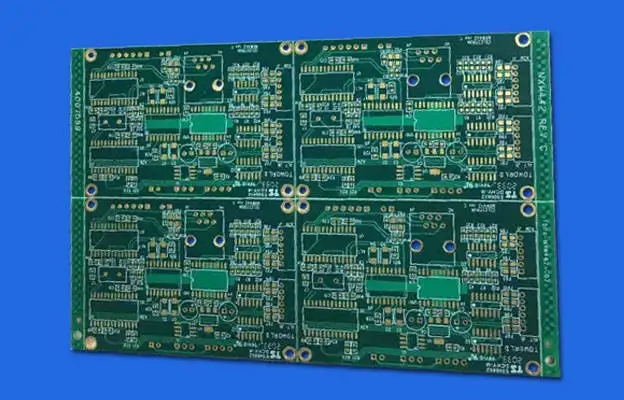
PCB manufacturers offer you PCB layout and routing skills Q 3
Now, although there are many software that can realize PCB automatic layout and routing. However, as the signal frequency continues to increase, in many cases, engineers need to understand the basic principles and skills of PCB layout and wiring to make their design perfect.

51. Q: Due to the limitation of the size of the board, my circuit board uses two sides of the chip to weld the chip. There are many vias on the board, and the signal line is also nearby. Will this wiring interfere with the signal?
A: If it is a low-speed digital signal, it should not be a problem. Otherwise, the signal quality will be affected.
52. Question: When considering whether to do impedance matching for digital lines, it is to see whether the total time from signal transmission to reflection exceeds 20% of the rising edge. If it does, impedance matching is required. Do analog lines need impedance matching? How to consider?
A: Low frequency analog signals do not need to be matched. Of course, RF analog signals also need to be matched.
53. Question: For the complete ground plane, if there are many layers on the board using AD/DA chips, a complete analog ground and a complete digital ground can be provided; It is also possible to divide analog ground and digital ground on the two ground planes. Which is better or worse?
Answer: Generally speaking, the ground will be completely paved. Except for some special cases, such as the analog part and digital part of the board are obviously separated, which can be easily distinguished.
54. Question: When magnetic beads or MECCA are used to connect digital and analog ground, their frequency characteristics are used to ensure that the medium and high frequency components of the digital ground do not affect the analog ground, and that their levels are equal. So, what is the role of 0 ohm resistor connecting digital and analog ground? Sometimes it is only connected with a small piece of copper. Can you analyze it?
Answer: The equivalent circuit of the magnetic bead is equivalent to a band stop wave limiter, which can only significantly suppress the noise at a certain frequency point. The noise frequency needs to be estimated in advance to select an appropriate model. In case of uncertain or unpredictable frequency, the magnetic bead is not suitable. The 0 ohm resistor is equivalent to a very narrow current path, which can effectively limit the loop current and suppress noise. Resistance has attenuation effect in all frequency bands (0 Ω resistance also has impedance), which is stronger than magnetic bead. The copper sheet is similar to a 0ohm resistor.)
55. Q: How to avoid the noise introduced during wiring?
Answer: The digital ground and analog ground should be grounded at a single point, otherwise the digital ground return current will interfere with the analog circuit through the analog ground.
56. Question: How can PCB prevent the interference of sudden change signals such as PWM to analog signals (such as operational amplifiers), and how can PCB test the size of such interference (radiated interference or conducted interference)? In addition to the layout and routing, are there any other methods to suppress (except shielding)?
Answer: Start with several interfaces of the operational amplifier, and prevent space coupling interference and PCB crosstalk at the input end (layout improvement); The power supply requires decoupling capacitors of different capacities. The probe of the oscilloscope can be used to test the position mentioned above to determine where the interference comes from.
If the PWM signal is converted into DC control voltage through low-pass filtering, it can be filtered, or a small capacitor connected in parallel to the ground can make the PWM waveform rounded and reduce high-frequency components.
57. Question: In a circuit board, an ARM or FPGA often connects many RAM and FLAH devices. What should be paid attention to when connecting these main chips to these memories? Is there any limit on the number of vias? What is the pore size of vias commonly used in digital signals? Does the size of the via aperture have a great impact on the signal?
Answer: If the speed is greater than 100MHz, there should be no more than two vias on one signal line. The vias should not be too small. Generally, 10 mils of aperture is enough.
58. Question: When double panel (high frequency) is used, will there be as few vias as possible when the top floor is connected to the bottom floor? So how to release the vias reasonably?
Answer: The number of vias is limited to the signal line. If it is a ground vias, the appropriate number will reduce the ground loop and impedance. The principle of placement is to enter the device as soon as possible.
59. Q: What should be paid attention to in LVDS signal wiring? How to wire?
Answer: Parallel equal length;
60. Question: Is the parallel cabling of data lines for mutual interference?
Answer: Pay attention to the distance between lines in parallel routing to prevent crosstalk.
61. Question: In a 4-layer board, there is a whole acquisition system, including analog amplification, digital acquisition and MCU. After layout, how to measure the input impedance of the system, how to match the input impedance of the system with the sensor, and how to match. Is there any relevant design principle?
Answer: I don't know how high the frequency of your analog signal is. If it is not high, impedance matching is not required. Impedance matching can use some simulation software to calculate the impedance of PCB. For example, AppCAD. The impedance of the device can be inquired through the manual.
62. Q: It is often seen that there are many floor holes on the PCB. Is the more floor holes the better? Are there any rules?
Answer: No. Try to reduce the use of vias. If you have to use vias, you should also consider reducing the impact of vias on the circuit.
63. Question: It is inevitable that there will be cross plane phenomenon when wiring multilayer boards. Our current cooking is to give priority to the difference line not crossing the plane when cutting the plane. However, it is thought that the teacher's statement is that the single end cannot be crossed, and the difference is not so strict. Can you tell me your teacher's opinion?
A: Both the single ended and differential signals have to return after crossing the ground plane. If the return loop is very large, more interference will be induced. If the noise on the differential line is the same, they will cancel each other, so it is reasonable.
64. Question: When designing high-speed multilayer PCB, how to distinguish between digital and analog? Is the connection made according to the instructions in the device's data manual?
Answer: High speed design does not include digital and analog.
65. Question: How to consider the fusing current of PCB wiring?? What factors are related to the fusing of PCB wiring when the current is high?
Answer: Reference 0.15 × Line width (mm)=A, current. The fuse current cannot be used as a budget during design. This is the sectional area of the copper wire.
66. Question: What protection is required for signal input/output interface and power input interface? When the power supply is 220V input to DC, what protective measures should be taken in practical application?
Answer: TVS tube and fuse are necessary on the power supply. For signals, TVS tubes and diodes should be added depending on the situation to protect the analog circuit input from high voltage.
67. Question: There are two types of PCB wiring bending: 45 degree angle and arc. What are the advantages and disadvantages? How to choose?
Answer: From the perspective of impedance matching, both lines can be made into matching corners. However, fillets may not be easy to machine.
68. Question: If the size of high-frequency cabling is limited, what are the common or reasonable cabling methods? For example, snake shaped wiring, is it OK?
A: No, more parasitic parameters will be introduced.
69. Question: What is the key input model when using the instrument amplifier? Is it necessary for me to cover copper around the device layer? I have covered copper on the bottom layer of the device. Also, the feedback resistance of the instrument amplifier is inserted directly, so the lead is long. The resistance temperature drift of the patch cannot meet the requirements. What should I do?
Answer: Generally, the instrument amplifier chip materials will have recommended layout methods and diagrams for reference. It is necessary to ensure that the lead wire is short and thick. The choice of low resistance or high resistance depends on the specific debugging results.
70. Question: PCB software can automatically route, but does the placement of components have to be manually placed?
Answer: The layout and routing are completed manually.
71. Question: Are there any special regulations or general methods for selecting PCB materials when making PCB boards? I am now making high-frequency signal circuit board. What kind of PCB do you prefer?
Answer: At present, the high-frequency circuit board substrate is fluorous dielectric substrate, such as polytetrafluoroethylene (PTFE), usually called Teflon, which is usually used above 5GHz. Just follow the PCB manufacturer's instructions when making the board.
72. Question: I'm a beginner in PCB design. What are the selection rules of the decoupling capacitor? How to calculate the value?
Answer: In general, 10u and 0.1u capacitors are used to decouple the power generation part, and high frequency and low frequency decoupling should be considered at the same time; For other components, 0.1u capacitor is generally used to decouple the power supply.
73. Question: How much can a 5 khz pulse signal attenuate when it travels 20 cm long and 10 mil wide on the board?
Answer: The parasitic parameters of PCBs made of different materials are different. You can build a model to calculate the parasitic parameters you use.
74. Question: Are there any requirements for the distance between the microstrip line running in high frequency and the ground plane? For example, it is greater than 1mm. Or there is no big requirement, as long as it is almost enough? Or should it be calculated as coplanar waveguide?
Answer: The impedance of coplanar waveguide or microstrip line must be simulated.
75. Q: How can we minimize the crosstalk of high-frequency signals between lines by wiring?
A: Well matched high-frequency signals will reduce reflection and radiation.







